
Macedonia, also called Macedon, was an ancient kingdom on the periphery of Archaic and Classical Greece, and later the dominant state of Hellenistic Greece. The kingdom was founded and initially ruled by the royal Argead dynasty, which was followed by the Antipatrid and Antigonid dynasties. Home to the ancient Macedonians, the earliest kingdom was centered on the northeastern part of the Greek peninsula, and bordered by Epirus to the west, Paeonia to the north, Thrace to the east and Thessaly to the south.

Philip V was king (Basileus) of the ancient Kingdom of Macedonia from 221 to 179 BC. Philip's reign was principally marked by an unsuccessful struggle with the emerging power of the Roman Republic. He would lead Macedon against Rome in the First and Second Macedonian Wars, losing both but allying with Rome in the Roman-Seleucid War towards the end of his reign.

Alexander IV, erroneously called sometimes in modern times Aegus, was the son of Alexander the Great and Princess Roxana of Bactria.

Brasidas was the most distinguished Spartan officer during the first decade of the Peloponnesian War.

Perdiccas III was king of the ancient Greek kingdom of Macedonia from 365 BC to 360 BC, succeeding his brother Alexander II.

The Bisaltae were a Thracian people on the lower Strymon river, who gave their name to Bisaltia, the district between Amphipolis and Heraclea Sintica on the east and Crestonice on the west. They also made their way into the peninsulas of Acte and Pallene in the south, beyond the river Nestus in the east, and are even said to have raided Cardia.
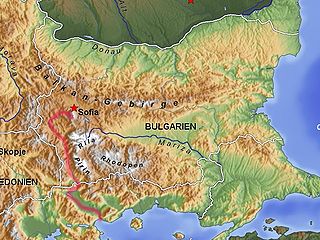
The Struma or Strymónas is a river in Bulgaria and Greece. Its ancient name was Strymṓn. Its drainage area is 17,330 km2 (6,690 sq mi), of which 10,797 km2 (4,169 sq mi) in Bulgaria, 6,295 km2 (2,431 sq mi) in Greece and the rest in north Macedonia. It takes its source from the Vitosha Mountain in Bulgaria, runs first westward, then southward, forming a number of gorges, enters Greek territory at the Kula village. In Greece it is the main waterway feeding and exiting from Lake Kerkini, a significant centre for migratory wildfowl. The river flows into the Strymonian Gulf in Aegean Sea, near Amphipolis in the Serres regional unit. The river's length is 415 kilometres.

In antiquity, Paeonia or Paionia was the land and kingdom of the Paeonians (Παίονες).

The Companions were the elite cavalry of the Macedonian army from the time of king Philip II of Macedon, achieved their greatest prestige under Alexander the Great, and have been regarded as the first or among the first shock cavalry used in Europe. Chosen Companions, or Hetairoi, formed the elite guard of the king (Somatophylakes).
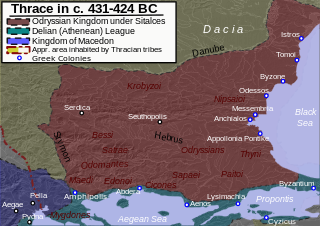
The Odrysian Kingdom was a state union of over 40 Thracian tribes and 22 kingdoms that existed between the 5th century BC and the 1st century AD. It consisted mainly of present-day Bulgaria, spreading to parts of Southeastern Romania, parts of Northern Greece and parts of modern-day European Turkey.
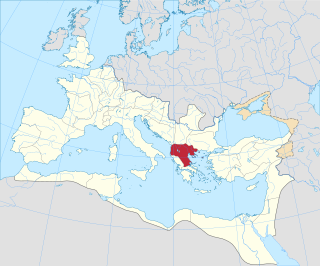
The Roman province of Macedonia was officially established in 146 BC, after the Roman general Quintus Caecilius Metellus defeated Andriscus of Macedon, the last self-styled King of the ancient kingdom of Macedonia in 148 BC, and after the four client republics established by Rome in the region were dissolved. The province incorporated ancient Macedonia, with the addition of Epirus, Thessaly, and parts of Illyria, Paeonia and Thrace. This created a much larger administrative area, to which the name of 'Macedonia' was still applied. The Dardanians, to the north of the Paeonians, were not included, because they had supported the Romans in their conquest of Macedonia.
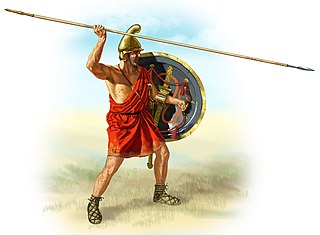
The army of the Kingdom of Macedon was among the greatest military forces of the ancient world. It was created and made formidable by King Philip II of Macedon; previously the army of Macedon had been of little account in the politics of the Greek world, and Macedonia had been regarded as a second-rate power.

Eion, ancient Chrysopolis, was an ancient Greek Eretrian colony in Thracian Macedonia specifically in the region of Edonis. It sat at the mouth of the Strymon River which flows into the Aegean from the interior of Thrace. It is referred to in Thucydides' History of the Peloponnesian War as a place of considerable strategic importance to the Athenians during the Peloponnesian War.
Politarch was a Hellenistic and Roman-era Macedonian title for an elected governor (archon) of a city (polis). The term had been already attested in the Acts of the Apostles (17:6,8) concerning Thessalonica, as well in modern archaeology. The institution is called Politarchate and the variant ptoliarchos appears in a poetic epigram. The first evidence of the title is dated to the reign of Perseus in Amphipolis, where the king with two politarchs honoured Artemis Tauropolos after a Thracian campaign. One of the earliest extant inscriptions to use the term "Politarch" was located on the Vardar Gate in Thessaloniki. The Gate was unfortunately destroyed in 1876 but the inscription, which dates to the 2nd Century AD, can now been seen in the British Museum in London.

Under the reign of Philip II, the kingdom of Macedonia, initially at the periphery of classical Greek affairs, came to dominate Ancient Greece in the span of just 25 years, largely thanks to the personality and policies of its king. In addition to utilising effective diplomacy and marriage alliances to achieve his political aims, Philip II was also responsible for reforming the ancient Macedonian army into an effective fighting force. The Macedonian phalanx became the hallmark of the Macedonian army during his reign and the subsequent Hellenistic period. His army and engineers also made extensive use of siege engines.
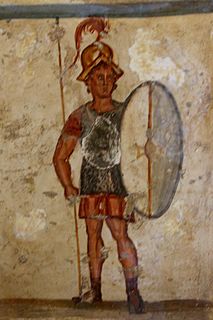
The Antigonid Macedonian army was the army that evolved from the ancient Greek kingdom of Macedonia in the period when it was ruled by the Antigonid dynasty from 276 BC to 168 BC. It was seen as one of the principal Hellenistic fighting forces until its ultimate defeat at Roman hands at the Battle of Pydna in 168 BC. However, there was a brief resurgence in 150-148 during the revolt of Andriscus, a supposed heir to Perseus.
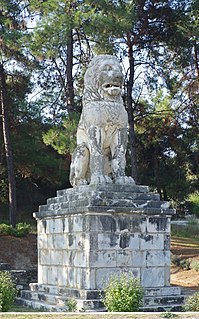
The Lion of Amphipolis is a 4th-century BC tomb sculpture in Amphipolis, Macedonia, northern Greece. According to Oscar Broneer and archaeologist Dimitris Lazaridis, the first person excavating in the area in the 1960s, it was set up in honor of Laomedon of Mytilene, an important general of Alexander the Great, king of Macedon.

The earliest government of Macedonia was established by the Argead dynasty of Macedonian kings some time during the period of Archaic Greece. Due to shortcomings in the historical record, very little is known about the origins of Macedonian governmental institutions before the reign of Philip II of Macedon, during the final phase of Classical Greece. These institutions continued to evolve under his successor Alexander the Great and the subsequent Antipatrid and Antigonid dynasties of Hellenistic Greece. Following the Roman victory in the Third Macedonian War and house arrest of Perseus of Macedon in 168 BC, the Macedonian monarchy was abolished and replaced by four client state republics. However, the monarchy was briefly revived by the pretender to the throne Andriscus in 150–148 BC, followed by the Roman victory in the Fourth Macedonian War and establishment of the Roman province of Macedonia.



















